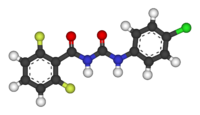Diflubenzuron
 |
|
 |
|
| Names | |
|---|---|
|
IUPAC name
N-[(4-Chlorophenyl)carbamoyl]-2,6-difluorobenzamide
|
|
| Other names
Dimilin
|
|
| Identifiers | |
|
3D model (Jmol)
|
|
| ChEBI | |
| ChemSpider | |
| ECHA InfoCard | 100.047.740 |
| KEGG | |
|
PubChem CID
|
|
| UNII | |
|
|
|
|
| Properties | |
| C14H9ClF2N2O2 | |
| Molar mass | 310.68 g·mol−1 |
| 0.08 mg/L | |
| Solubility in other solvents |
DMSO: 12 g/100 g Acetone 0.615 g/100 g Methanol: 0.09 g/100 g |
| Pharmacology | |
| QP53BC02 (WHO) | |
|
Except where otherwise noted, data are given for materials in their standard state (at 25 °C [77 °F], 100 kPa).
|
|
|
|
|
| Infobox references | |
Diflubenzuron is a benzoylurea-type insecticide of the benzamide class. It is used in forest management and on field crops to selectively control insect pests, particularly forest tent caterpillar moths, boll weevils, gypsy moths, and other types of moths. The mechanism of action of diflubenzuron involves inhibiting the production of chitin which is used by an insect to build its exoskeleton.It is widely used larvicide in India for control of mosquitoes larvae by public health authorities.The Diflubenzuron formulation is approved by WHOPES.
Diflubenzuron has been evaluated by the United States Environmental Protection Agency (EPA), and it is classified as non-carcinogenic. While 4-Chloroaniline, a metabolite of diflubenzuron, has been classified as a Carcinogen, it is not present in diflubenzuron. 4-Chloroaniline is produced after diflubenzuron has been ingested, and the body changes a small fraction of it to the metabolite. Diflubenzuron has been tested, and the small amount converted to 4-chloroaniline after ingestion does not cause cancer.
...
Wikipedia
